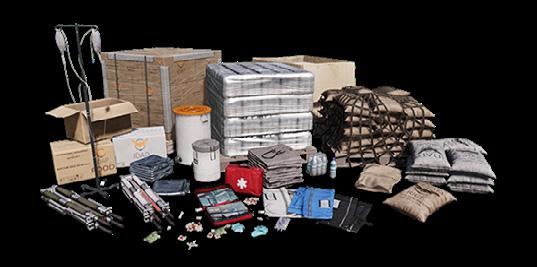Where TO Go to Get Financing with Challenged Credit or No Collateral…

flow requirements.
Where TO Go to Get Financing with Challenged Credit or No Collateral…
There are many great funding options for entrepreneurs with personal credit issues or who lack collateral. They include revenuebased financing, asset based financing, and equity financing. Also, they include crowdfunding and business credit. Or get unsecured financing using a credit partner/personal guarantor.
The truth is, there is a LOT of capital out there that business owners can get. This is so even with personal credit issues or no collateral. Most of it isn’t available through big banks. You can qualify for this massive amount of available financing based on your business strengths. This is as long as your business has even one strength. The big banks require your ENTIRE business and you to be near perfect to get money. But as you’re about to discover, there are many other sources who will lend you money, even lots of it, based on just one strength. Long as you have a strength to offset your weakness of having bad credit or lacking collateral, you can get approval. These are often called compensating factors.
Cash-flow Based Financing

Many businesses have already proven concept and have consistent increasing sales. Their strength is they have shown stability and they can run a growing business. The risk to the lender is less with established, growing businesses. How are your sales? Sales are the difference between an untested concept or idea, and a viable business. Will your idea be well received? Do YOU know how to operate a business? Sales answer these questions.
If you have consistent sales, the next question is: does the business have existing cash flow proven by bank statements? There are lending options available only requiring a quick bank statement review. They won’t even need to look at your tax returns. So even if your business shows a loss you’ll still be okay. The next question is: does the business have over $60,000 annually from
7 ©️2023 The Distributor of this e-Book, all rights reserved. No reproduction or use of any portion of the content or work or the entire work is permitted without the express written permission and authorization of the publisher. However the publisher of these materials routinely grants authorization for reproduction or use of this work,
whole or in part. If you would like to use any portion of this material in a book, article, e-zine, newsletter, radio, or television broadcast, podcast or in any other seminar teleconference or other events or publications please email or call the distributor of this guide. Business Loan Secrets
in
credit card sales? Does the business have over $120,000 annually going through their bank account? If so, then revenue financing or a merchant advance might be the perfect funding product.

For this type of cash flow based financing, you must be in business six months. No startup businesses can qualify. You should have at least 10 monthly deposits going through your bank account, not just a few larger deposits. Most advertising you see for bad credit business financing are these products. These are short term advances of 6 – 18 months. They are mostly short term at first, such as 3 – 6 month terms. Then when half is paid down, the lender will lend more money at a longer term, such as 12 – 18 months. Loan amounts typically go up to $500,000. Your actual loan amount is based on your revenue. Usually you can get a loan of 8 – 12% of annual revenue, based on verifiable revenue per your bank statements. For example, a company with $300,000 in sales might get a $30,000 advance to start.
500 credit scores are accepted for revenue and merchant financing. They are COMMON with this type of lending. Bad credit is okay, as long as you aren’t actively in trouble such as in a bankruptcy. You cannot have serious recent and unresolved tax liens or judgments.
Depending on risk, cash flow financing rates of 10 – 45% are common. Risk factors include industry and time in business. More risk factors are bank statement details. These details include number of deposits, average daily balance, NSF charges, and amount of deposits monthly. Credit quality is another factor. Often rates are higher on first advance until you prove yourself to the lender. Tax returns, other income documents, and collateral are not required.
You won’t need to pledge any collateral to get approved. But you will typically be required to supply a personal guarantee. This is required for almost all business financing not accompanied by collateral.
Asset Based Financing
Asset based financing is also called collateral based lending. With this financing, the basis of your loan comes from the strength of your collateral. Since your collateral offsets the
8
events or publications
email
call
this
Business Loan Secrets
©️2023 The Distributor of this e-Book, all rights reserved. No reproduction or use of any portion of the content or work or the entire work is permitted without the express written permission and authorization of the publisher. However the publisher of these materials routinely grants authorization for reproduction or use of this work, in whole or in part. If you would like to use any portion of this material in a book, article, e-zine, newsletter, radio, or television broadcast, podcast or in any other seminar teleconference or other
please
or
the distributor of
guide.
lender’s risk, you can get approval with bad credit. You can still get REALLY good terms. Common BUSINESS collateral might include account receivables, inventory, and equipment.
With account receivable financing you can secure up to 80% of receivables within 24 hours of approval. You must be in business for at least one year and receivables must be from another business. Rates are commonly 1.25 – 5%.
You can also use your inventory as collateral for financing and secure inventory financing. The smallest inventory loan amount is $150,000 and the general loan to value (cost) is 50%. Thus, inventory value would have to be $300,000 to qualify. Rates are normally 2% monthly on the outstanding loan balance. A typical borrower is a factory or retail store.
With equipment financing, lenders undervalue equipment by up to 50% and work with major equipment only. Lender won’t combine a bunch of small equipment, and first and last month’s payments are necessary to close. Loan amounts are available typically up to $2 million dollars.
401(k) and stocks are common PERSONAL collateral that can qualify for collateral based lending. Use a 401(k) or IRAs to get up to 100% financing. Rates are usually less than 3%. A retirement plan is created allowing for investment into the corporation. Funds roll over into the new plan. The new plan purchases stock in corporation and holds it. The corporation is debt-free and cash rich.
With securities based lines of credit you can get an advance for up to 70 – 90% of the value of your stocks and bonds. These work much the same as 401(k) financing with similar terms and qualifications.
Equity Financing and Crowdfunding

With equity financing, you exchange a percentage of ownership in your business for financing, much like on the TV show Shark Tank . Personal credit is NOT an issue. You won't need to provide collateral. But equity investors are looking for a tested and proven concept.
©️2023 The Distributor of this e-Book, all rights reserved. No reproduction or use of any portion of the content or work or the entire work is permitted without the express written permission and authorization of the publisher. However the publisher of these materials routinely grants authorization for reproduction or use of this work, in whole or in part. If you would like to use any portion of this material in a book, article, e-zine, newsletter, radio, or television broadcast, podcast or in any other seminar teleconference or other events or publications please email or call the distributor of this guide.
9
Business Loan Secrets
Sales help with approval. You might find some investors to invest in a concept only, or invention. But most will want to see you have an operating business earning money and making profits.

And expect them to want a large piece of the equity. For it to be worth their time to invest, they might want 10 – 60% ownership of your business. That means they’ll be taking a large part of your future earnings. It's something you want to consider before recruiting an investor.
There are lots of websites where you can get crowdfunding for your business. This type of funding gathers money from a crowd, or a lot of people instead of one big investor. If the crowd likes your idea, they may donate money to your project. Much of crowdfunding doesn’t need to be paid back and many investors are people you know. Look into crowdfunding and you’ll find there are all types available.
Some types of crowdfunding sources want a certain percentage of return. Some want a percent of equity ownership. There are different sources and platforms for different needs, and even for unique niches or industries. Make sure you find the right crowdfunding platform for you before you post a project.
Business Credit and Unsecured Credit
Business credit is a great way to get money. Approvals are not based on personal credit. No collateral is necessary for approval. Business credit reports usually start with a few vendor accounts offering initial credit. Initial accounts create tradelines and a credit profile which establish a score. The company’s new profile and score are used to get credit. Newly-obtained credit is based on the company’s credit per the EIN, not the owner’s credit based on the SSN. Personal credit doesn’t matter as the credit linked to the EIN is used for approval.
When you use vendors to build initial credit, they may want your SSN on the application for identification purposes. But you can still apply
10
material
article,
newsletter,
television broadcast, podcast
seminar teleconference
other events or publications please email or call the distributor of this guide. Business Loan Secrets
©️2023 The Distributor of this e-Book, all rights reserved. No reproduction or use of any portion of the content or work or the entire work is permitted without the express written permission and authorization of the publisher. However the publisher of these materials routinely grants authorization for reproduction or use of this work, in whole or in part. If you would like to use any portion of this
in a book,
e-zine,
radio, or
or in any other
or
for business credit based solely on your EIN at most retail stores. You can get cash credit also, like high-limit cards with MasterCard. But building business credit all starts with vendor accounts. Without them, you won’t be able to start your credit profile. Building a profile is the key to getting cash and retail credit cards for your business.
Once you apply for vendor credit, use your credit. It takes about 1 – 3 months for those accounts to report to the business credit bureaus. Once those accounts are reported, a business has a business credit profile and score. This can be used to get retail credit cards next. Once you have about more payment experiences reporting, you can start to get cash credit like MasterCard accounts. A payment experience is the reporting of an account to one business credit bureau.
You can get approval for vendor accounts right away which offer credit on Net 30 terms. Once you use those accounts they are reported, which takes about 30 – 90 days. Then, in only 90 days or less, you can use your newly built credit to start to get high-limit retail credit cards. About 30 – 90 days later, you can get approval for $5,000 – 10,000 limit cash credit cards you can use almost anywhere. Due to this fast building and approval time, business credit makes a lot of sense for credit challenged entrepreneurs.
Unsecured credit requires no collateral, but it DOES require good credit. But if you have credit issues, you can still get approval if you have a good credit partner. Or you can work with someone who will sign as a guarantor, who has good credit. The guarantor is then liable for the business debt in case the account defaults. Approval amounts range from $10,000 to $150,000. Card limits are equal to what the signer has on their credit now. These accounts often report to the business credit bureaus. So, they also help build your business credit. And they are NOT reported on the guarantor’s personal credit report. Your guarantor will need excellent personal credit to qualify.
©️2023 The Distributor of this e-Book, all rights reserved. No reproduction or use of any portion of the content or work or the entire work is permitted without the express written permission and authorization of the publisher. However the publisher of these materials routinely grants authorization for reproduction or use of this work, in whole or in part. If you would like to use any portion of this material in a book, article, e-zine, newsletter, radio, or television broadcast, podcast or in any other seminar teleconference or other events or publications please email or call the distributor of this guide.
11
Business Loan Secrets











